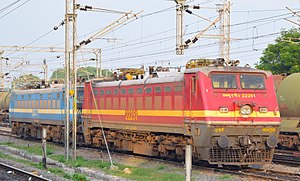WAP 4E
| WAP-4 | |||||||||||||||||||||||||||||||||||||
|---|---|---|---|---|---|---|---|---|---|---|---|---|---|---|---|---|---|---|---|---|---|---|---|---|---|---|---|---|---|---|---|---|---|---|---|---|---|

A WAP4 attached to WAG7 at Kazipet Junction
|
|||||||||||||||||||||||||||||||||||||
|
|||||||||||||||||||||||||||||||||||||
|
|||||||||||||||||||||||||||||||||||||
|
|||||||||||||||||||||||||||||||||||||
|
|||||||||||||||||||||||||||||||||||||
| Type and origin | |
|---|---|
| Power type | Electric |
| Builder | Chittaranjan Locomotive Works, West Bengal, India |
| Build date | 1993 till December 2, 2015 |
| Total produced | 776 as of August 2016 (Production Ceased) |
| Specifications | |
|---|---|
| Configuration: |
|
| • AAR | C-C |
| • UIC | Co'-Co' |
| Gauge | 5 ft 6 in (1,676 mm) |
| Bogies | Co-Co Flexicoil Mark 1 cast bogies; primary and secondary wheel springs with bolsters |
| Wheel diameter | New:1,092 mm (3 ft 7 in) Half worn: 1,055 mm (3 ft 5 1⁄2 in) Full worn: 1,016 mm (3 ft 4 in) |
| Length | 18.794 m (61 ft 7 29⁄32 in) |
| Width | 3.179 m (10 ft 5 5⁄32 in) |
| Height | 4.272 m (14 ft 3⁄16 in) |
| Axle load | 18,800 kg (41,400 lb) |
| Loco weight | 112,800 kg (248,700 lb) |
| Electric system(s) | 25 kV 50 Hz AC AC Overhead |
| Current source | pantograph |
| Traction motors | Hitachi HS15250 |
| Loco brake | Air/[hand brakes] |
| Train brakes | Air |
| Safety systems | Slip control, Over voltage relay, Main overload relay, Earth Fault Relay, Low Pressure Governor, Brake Cylinder Cutoff Valve, Train parting alarms and No OHE volt relay |
| Performance figures | |
|---|---|
| Power output | Continuous: 5,060 hp (3,773 kW) |
| Tractive effort | 30,800 kgf (302 kN; 68,000 lbf) |
| Career | |
|---|---|
| Operators | Indian Railways |
| Numbers | 22061 and from 22201 to 22999 and 25000 to 25051 |
| Locale | All over India |
| Disposition | Active |
WAP - 4 is a widely used passenger electric locomotive used in India.
The locomotive was developed after a previous class WAP-1 was found inadequate to haul the longer, heavier express trains (24-26 coaches) that were becoming the mainstay of the Indian Railways network. It was introduced in 1994, with a similar bodyshell to the WAP-1 class, but with Hitachi traction motors.
Electricals are traditional DC loco type tap changers, driving 6 traction motors arranged in Co-Co fashion. This locomotive has proved to be highly successful, with over 750 units in service. Newer examples have been fitted with Microprocessor Controlled diagnostics, Static Converter units (instead of arnos) and roof mounted Dynamic (Rheostatic) Brakes.
The locomotive can be seen in service across the electrified network of Indian Railways and is based out of 14 sheds (depots).
The last locomotive produced by the Chittaranjan Locomotive Works (CLW) was numbered 25051 in December 2015 and production of this locomotive has been stopped.
The loco has a streamlined twin cab carbody design, with top-mounted headlamps. The first 150 or so units had the headlamp mounted at waist level, with the lights being mounted in a protruding nacelle. Some earlier locos, especially from the Erode loco shed have the headlamps placed on the top. Later on the headlamps were placed in a recessed nacelle, and from road #22579 onward, the headlamps were moved to the top. Also they have digital notch repeaters.
Newer locos also feature larger windshields, more spacious driver cabin with bucket type seats and ergonomic controls. The control panel also features a mix of digital and analog displays in newer units (all analog display in older versions).
Original units were weighed 120 tonnes, which was brought down to 112 tonnes through the usage of lighter material.
Some of the WAP-1 and WAP-3 and all the WAP-6 units were rebuilt to WAP-4 specifications after replacing the bogies & electricals.
It has different underframe for handling larger buffing loads. Some units are fitted with speed recorders and some changes to control electronics. Some units also have data recorders for energy consumption. Some are even fitted with windshield washers. Few were provided with signalling lamps.
Technical variants include WAP-4E which are probably fitted with electronic sensor for sensing loss in pressure in pipes.
The Hitachi traction motors are the ones used on freight engines. It was a challenge to put these in a passenger engine due to weight constraints. So the transformer is aluminum foil-wound and aluminum chequered plates are used for reducing the weight.
...
Wikipedia
